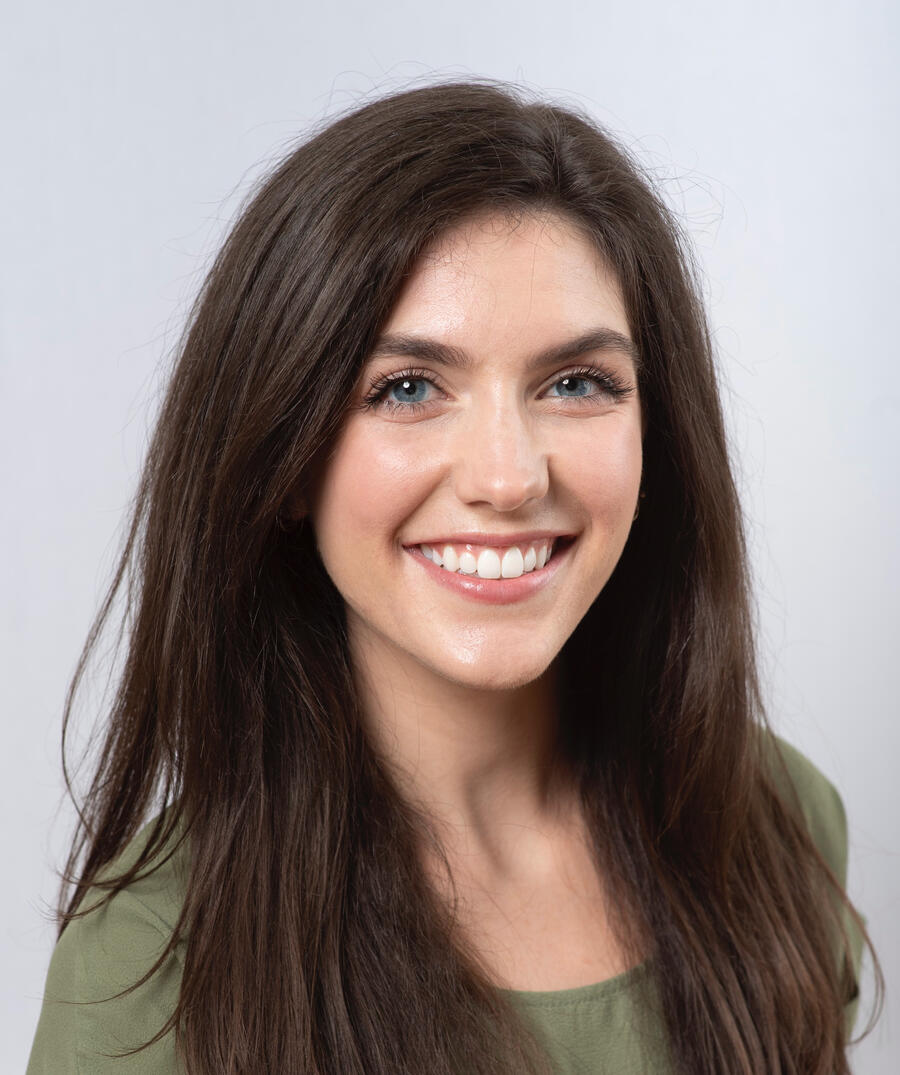Through a Patient's Eyes
A Visual Storytelling Project Exploring One Individual's Cancer JourneyCreated by Taylor Schofield, artist and 4th year medical student at the Frank H. Netter MD School of Medicine at Quinnipiac University
Purpose
"Through a Patient's Eyes" is a medical humanities project created with the goal of humanizing the patient experience by highlighting the non-clinical impact of life-altering illnesses like cancer. A cancer diagnosis can affect many areas of a patient's life, including physical and mental health, interpersonal relationships, self-esteem, spirituality, financial health, employment, and more. To provide holistic care for these patients, clinicians should be conscious of and empathetic about the impact that cancer can have on these areas.Most medical students enter training with a natural sense of empathy and a desire to connect with patients in a positive way. Unfortunately, research has shown that empathy tends to decline during medical school. The field of medical humanities, which evaluates how written and visual arts, social sciences, philosophy, and sociology relate to medicine, has been shown to have a positive impact on empathy scores in medical students. The field of medical humanities provides unique insight into the human condition within the context of medical intervention, illness, and suffering, helping clinicians remember the person behind the diagnosis."Through a Patient's Eyes" depicts one patient's journey through the diagnosis of, treatment of, and recovery from cancer. By sharing this story through a medical humanities lens as a written and visual arts project, it is my goal for medical students, physicians, and other healthcare professionals who interact with this project to reflect on the experiences of this patient, then apply what they learned to the care of their own patients.
Chapter 1: The Phone Call
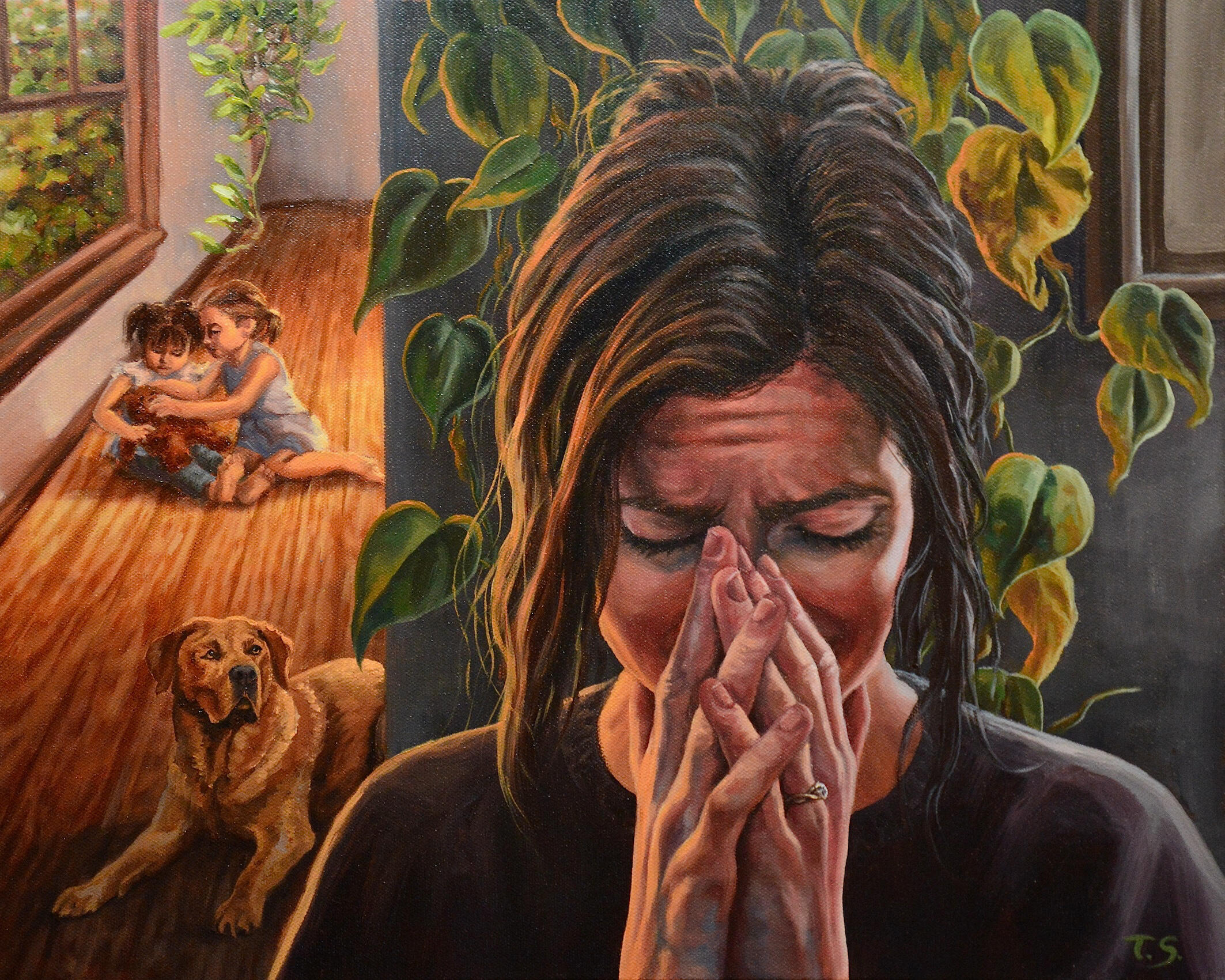
Spend a few moments viewing the oil painting above, titled, "The Phone Call"Next, answer the following reflection questions:1. What do you think is happening in this scene?2. What does this image make you feel?3. What relationships do you think exist within this painting?Next, read Chapter 1: The Phone CallI remember when I first noticed the lump. I called my mom. I said, “This is probably nothing, right?” I was young, completely healthy. I felt totally normal. My mom gently encouraged me to see my doctor. “It's probably nothing, don't worry honey.” I could hear a hint of concern in her voice.I don't remember feeling particularly worried at my appointment with my primary care doctor, even as her brow furrowed while she ordered tests for me. I remember brushing it off. I was in my 30s. I was a mom of two little girls. I was balancing my career and motherhood and marriage. I felt invincible.I still wasn’t worried on the day of my ultrasound. The technician was friendly and chatty until she suddenly fell silent during the test. A heaviness settled over us. She quietly excused herself before the radiologist entered the dark room. He told me that I needed a referral for a biopsy. They weren’t sure what the lump was, but they needed to rule out cancer.Cancer. The rest of the day was a blur. There were phone conversations with my primary care doctor, but I can’t remember anything she told me. I had never even considered the possibility that something might actually be wrong. Hearing the word, “cancer,” felt like plunging into ice water. It stole my breath and jolted me out of a peaceful daydream. I called my husband on the way home and told him that I was scared.The following weeks were full of specialist appointments, waiting, more tests, an inconclusive biopsy, a surgery, and more waiting. When I think back on that time, I mostly remember the fear. Life continued, but my mind was foggy, enveloped by uncertainty and a dreadful sense of foreboding. My heart raced every time the phone rang. I kept myself busy and avoided thinking about it. The idea of being sick still felt preposterous, like an outlandish nightmare. I told myself that they were going to call and tell me that everything was fine, the lump was benign, and I could forget about this forever. Deep down, under layers of denial, I think I probably knew the truth.I was at home when I got the phone call. My parents were visiting. They were sitting next to me on the couch while my girls played on the living room floor. All eyes were on me as I answered the phone. I heard my doctor’s voice telling me to stay calm and take a deep breath, he had to tell me something. My pathology results were back. They found cancer.I couldn’t hear the rest of what he said over the buzzing in my ears. Time stood still. I mumbled a thank you and ended the call with trembling hands. My parents stared at me expectantly. The room was silent. I walked slowly into the hallway and stared at the floor. I felt numb. As I traced the patterns of the floorboards with my eyes, my doctor’s voice danced through my head. “We found cancer.” The phrase echoed over and over until it became meaningless. Cancer. I couldn’t comprehend it. At the edges of my consciousness, I could hear my daughters playing in the living room while my parents spoke in hushed voices. Eventually, the weight of reality started to creep back in. They found cancer.After Reading Chapter 1, consider the following reflection questions:1. Does this story make you feel differently about the image? What moment do you think is being depicted?2. Imagine that you are this patient's primary care doctor:a. How would you have approached the conversation at her initial appointment? Would you have brought up cancer as a diagnosis you were worried about?b. As a primary care provider, how would you support this patient during her initial work-up phase? How would you coordinate care? What kind of follow-up plan would you have in place?c. What tools would you utilize for mental health screening in a patient with newly diagnosed cancer? What resources would you offer to provide multidisciplinary care for this patient’s mental health? (I.e. social work, behavioral health support, support groups, psychiatry referral?)3. Imagine that you are the radiologist who needs to tell this patient that her ultrasound shows features concerning for malignancy, and she needs an urgent biopsy. What strategies would you use to help the conversation go well? How would you ensure that this patient understands the information you are telling her?
Chapter 2: In the Storm
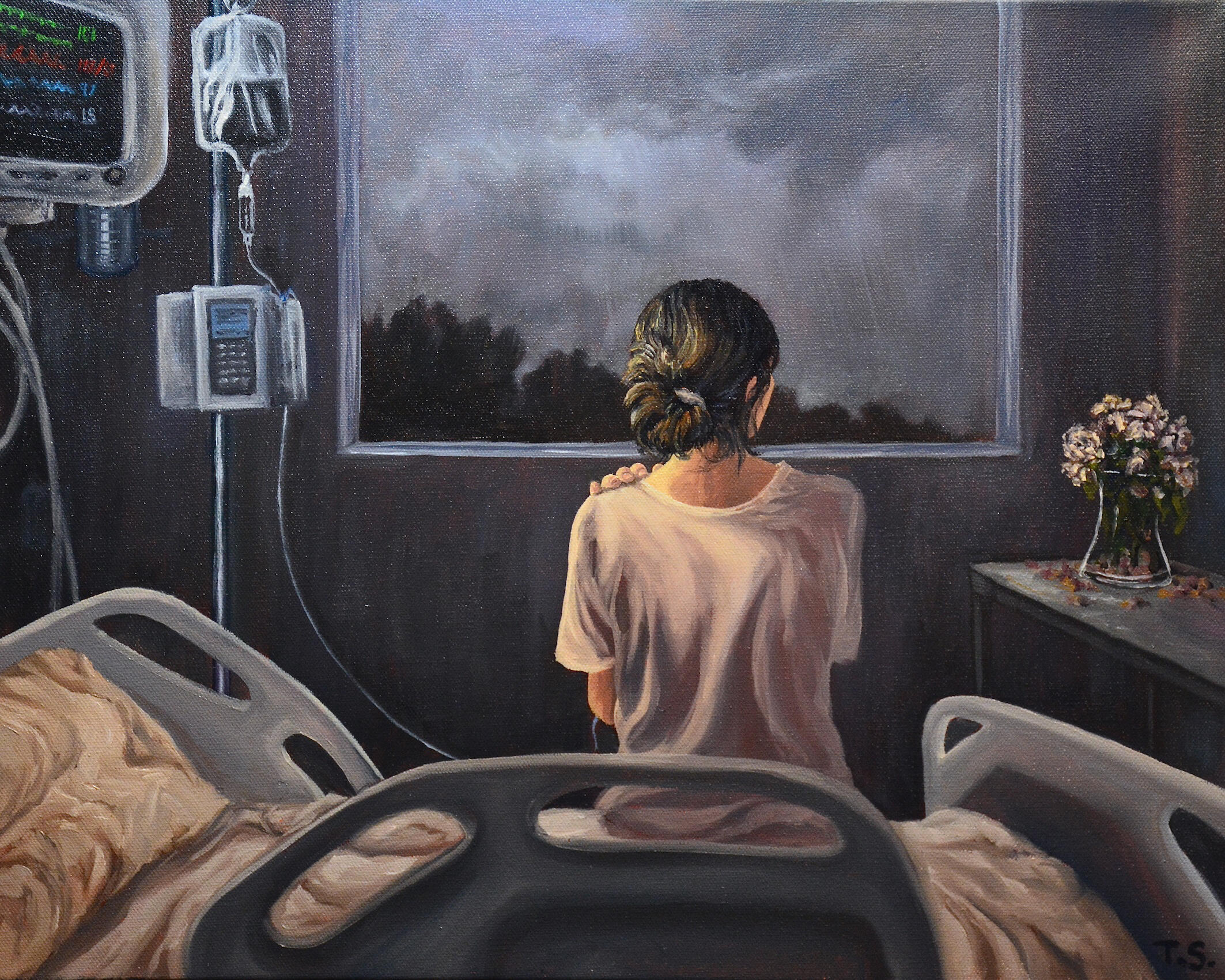
Spend a few moments viewing the oil painting above, titled, "In the Storm"Next, answer the following reflection questions:1. How does this image make you feel?2. What do you think the subject of this painting is feeling?Next, read Chapter 2: In the StormI had never been a very religious person before my cancer diagnosis. I didn’t grow up in a religious household, and I had never really put much thought into spirituality. But now that I was standing at this precipice, looking over the edge into the unknown, I found myself praying to a God that I hoped was real.I ended up walking into a church one night, maybe for the first time in my life. I was completely alone, and the silence was eerie. I sat down in the first row. I took slow, deep breaths as my disbelief, my fear, and my grief over my diagnosis washed over me like ocean waves crashing relentlessly onto the shore. I felt anger boiling beneath the surface and tried to push it down. How could this be happening to me now? My girls were so little. What if they had to grow up without a mom? How could that be fair? A lump formed in my throat as I silently bargained, “Please. Please let me raise these girls. I don’t care what happens to me after that. Please don’t let them grow up without a mom.”One of the weirdest things about being a cancer patient was that I didn’t really feel like a “Cancer Patient”. I just didn’t see myself that way. But everyone around me treated me differently once I was diagnosed. Friends and family were so somber as they gave me their condolences. Pity was etched all over their faces. It felt like they were walking on eggshells, so careful about what to say and how to say it. They reassured me that my scars weren’t as bad as I thought. “They’ll heal! Don’t worry! You still look beautiful.” Their kindness started to feel patronizing, and I was desperate for someone to be honest with me. More than anything, I just wanted to be treated like normal, like I was still myself. Despite being surrounded by supportive people, it was one of the loneliest times of my life.As I slogged through treatment, I remember feeling overwhelmed by the sheer amount of information. I clung to my care team’s advice like a lifeline. My doctors and nurses guided me through surgery, radiation, and treatment with medicines that I couldn’t pronounce. They helped me weigh the risks and benefits of each decision, and while it was intimidating to make those choices, it felt empowering to know that my goals mattered.I was grateful for the expertise of my care team. I felt like I could trust them with my life, but even beyond that, I deeply appreciated the ways that my providers understood me and cared about me. Looking back, I don’t really remember the details of what we talked about, but I do remember the way my doctors and nurses made me feel.The biggest moments were often found in the small moments. After my second surgery, I remember being alone in my hospital room, so anxious that I couldn’t physically sit still. The immense weight of the unknown felt like a raging storm in my mind, shrouding my reality in chaos and darkness. But I remember my nurse taking my hand and walking with me. We shuffled up and down the halls, over and over. I knew that she was busy that night, with many sick patients to take care of, but she spoke to me in a soothing voice and walked with me until I could finally breathe again. I will never forget her kindness.After reading chapter 2, consider the following reflection questions:1. Cancer can affect all spheres of a patient’s life, including physical health, emotional wellbeing, finances, interpersonal relationships, self-esteem, employment, and spirituality. If this was your patient, how would you monitor and provide support for these areas of her life?2. Imagine that you are in this patient’s shoes, and you have been recently diagnosed with cancer:a. What would you prioritize when deciding on a treatment plan? (For example: quality of life, prolonging survival, pain management?) How would you communicate these goals to your healthcare providers?b. What qualities would you look for and value most in your healthcare providers?3. Imagine that this patient is a family member. Do you think you would treat them differently after a new cancer diagnosis, either intentionally or unintentionally? How would you try to support them?
Chapter 3: A Sense of Peace
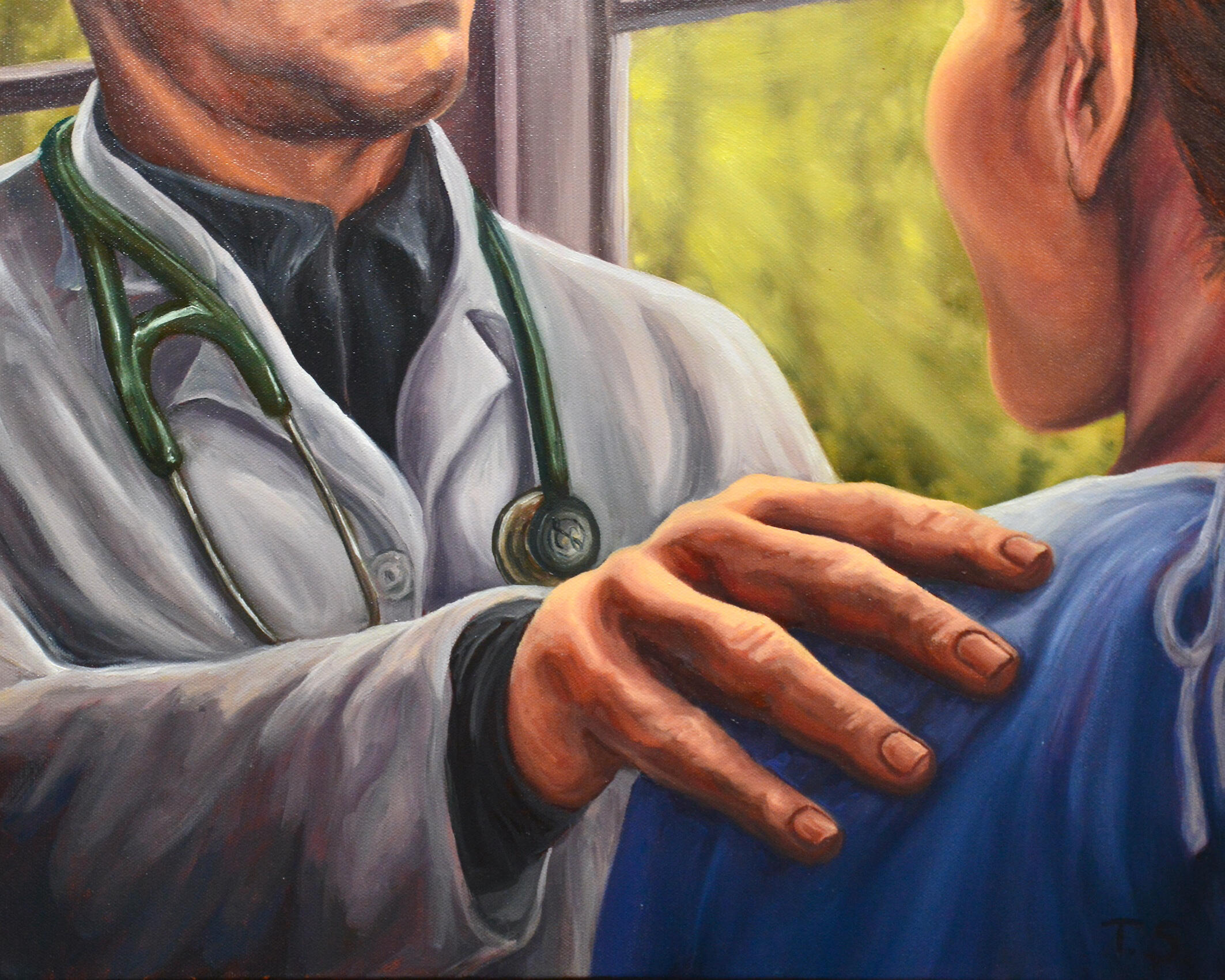
Spend a few moments viewing the oil painting above, titled, "A Sense of Peace"Next, answer the following reflection questions:1. What do you think is happening in this scene?2. How does this image make you feel?Next, read Chapter 3: A Sense of PeaceAs I progressed through treatment, I started to let myself feel cautiously hopeful. My surgeries were successful, my treatments appeared to be working. But deep down, fear and uncertainty loomed over me at every moment. I couldn’t escape and I couldn’t rest. It was physically and emotionally exhausting.One night I had a dream unlike anything I had ever experienced. In my dream, I knew that I was going to see someone special. I was making a card for this person, like I would have done when I was a child, but I didn’t know who I was going to see. I took my card and walked through a door into a room that was full of bright golden light. I looked up and my aunt was standing in front of me, smiling. My grandmother was in the kitchen behind her, cooking. Somewhere in my mind, I was conscious of the fact that both my aunt and grandmother had died when I was a young girl. But in this moment, all I could feel was immense love, warmth, and joy. It was the most amazing feeling I had ever experienced, and I thought to myself, “This must be what heaven feels like.” My aunt stepped forward and hugged me tightly. She took my hand, looked into my eyes, and said, “Everything is going to be okay.” I could feel the warmth of her touch, the callouses on her hands. I could smell her perfume. It felt so real, like she was truly there with me.And then I woke up. The warmth slowly faded, and I squeezed my eyes shut as tears slid down my cheeks. Everything was going to be okay. I silently said thank you.Things felt easier after the dream. I wasn’t afraid anymore. I knew everything would be okay, even if I died, because I wasn’t afraid of dying anymore. A sense of peace and acceptance carried me through the rest of my treatment.About a year had passed since my diagnosis, and it was time to review the results of my most recent imaging to find out if my treatments had worked, or if the cancer had returned. I remember sitting in the waiting room of my doctor’s office, picking at the edges of my nails as the seconds ticked by impossibly slowly. I took deep breaths and pushed down fleeting surges of panic. I thought about my dream. I repeated my mantra to myself, “Everything is going to be okay.” No matter what. Even if the cancer was back. I was going to be okay no matter what. I desperately tried to convince myself that it was true.Suddenly my doctor burst through the waiting room door with a huge smile on his face. “I just got your results,” he said breathlessly, “I couldn’t wait to tell you!” I felt myself stand up, hands wringing in anticipation. He placed a reassuring hand on my shoulder.“You are cancer-free. I am so happy for you.”I felt lighter than I had ever felt. The weight that I had been carrying for a year, that had dug its claws so deep into the core of my being, that had tormented me and pushed me to my limits, faded into nothingness. I was free. The moment was indescribable.After reading chapter 3, consider the following reflection questions:1. What themes do you notice in this part of the story? What factors do you think contributed to this patient’s shift in mindset?2. Based on this physician’s behavior, do you feel like he cares about this patient? What aspects of his communication are most important?3. Imagine that you are this patient’s primary care provider. How would you plan your follow up care after learning that your patient is cancer-free?
Chapter 4: On the Other Side
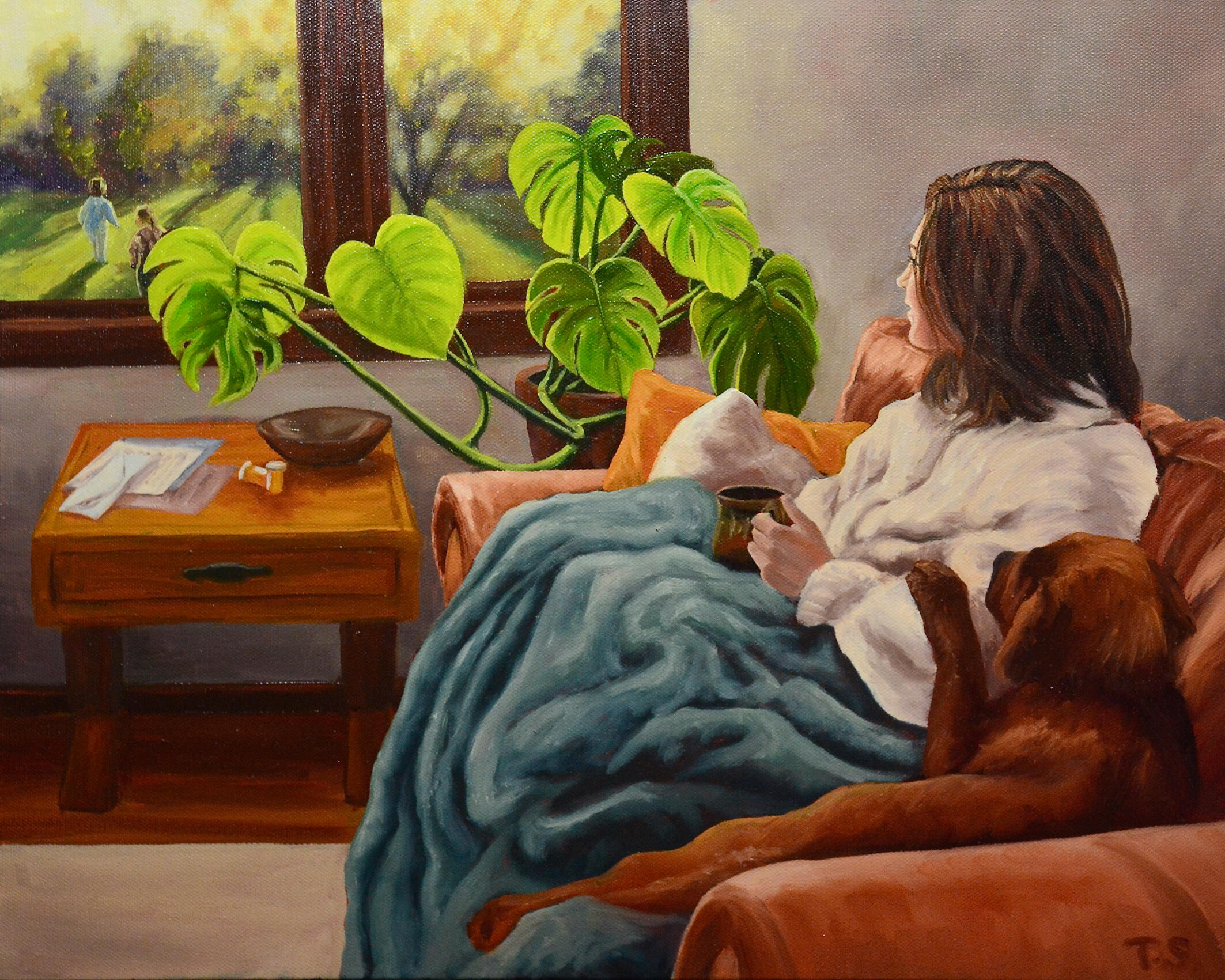
Spend a few moments viewing the oil painting above, titled, "On the Other Side"Next, answer the following reflection questions:1. How does this scene make you feel?2. Do you notice any details in this painting that you feel are symbolic? Do you think any of the details are significant to the patient in our story?Next, read Chapter 4: On the Other SideI had convinced myself that my life would return to normal after going through cancer. Of course, that couldn’t be true. My life had changed, and I had changed.Much to my chagrin, many people in my life still treated me differently when I became a cancer survivor. They still looked at me with pity, as they asked in hushed voices, “How are you feeling?” I didn’t want to talk about my cancer! I wanted to talk about my family and my job and my goals and my dreams! I wanted to move on and never think about cancer ever again.But that would be impossible, and I knew it, I just didn’t want to accept it. My new reality was taking medication every day for the rest of my life and going in for regular appointments, bloodwork, and scans to make sure that the cancer stayed away. My doctors warned me that I now had an increased risk for other types of cancer, which felt like a cruel and unusual punishment.Prior to having cancer, I felt invincible. I knew that bad things could happen, but I always felt like they would never happen to me. You just never think it will happen to you. But it can, and it does. I realized that we are vulnerable, and life is incredibly fragile. Your whole world could get turned upside down at any moment.I wouldn’t say that I live with fear now, but that sense of knowing is always present. We are not invincible.That knowledge can be painful to carry, but when I look back on my experience with cancer, I also think about the good that came of it.Cancer forced me to grow. It gave me a new perspective. I had been incredibly fortunate prior to my diagnosis, and truthfully, I had never faced any real adversity. Surviving cancer showed me that I was braver and more resilient than I had ever realized. I faced hardship and came out of it with a new strength. I started to believe in my own courage more deeply than ever before.I also found a new sense of gratitude. How lucky was I to survive cancer, when so many others never get to see the light of day on the other side? How lucky was I to get to watch my daughters grow up? To experience joy and love and heartbreak? To cry and laugh and taste and feel?Being alive is a gift. Cancer taught me to stop taking it for granted.After reading Chapter 4, consider the following reflection questions:1. With the development of increasingly effective cancer treatment modalities, cancer survival rates are increasing. According to the National Cancer Institute, in 2022 there were an estimated 18.1 million cancer survivors in the United States. This number is projected to increase by 24.4% by 2032, making cancer survivorship an important field for practitioners to be aware of. What are the long-term repercussions that cancer survivors face, and how would you guide and support this patient through survivorship as her physician?2. Think about how this patient reflects on her cancer experience. What issues do you think were the most difficult for her? Do you think she had enough support from her care team in dealing with these issues? Would you do anything differently if this was your patient?3. Do you think that going through cancer affects the way that patients might interact with the healthcare system in the future? How would you adjust your approach to communication with a patient who is a cancer survivor?
Final Reflection Questions
1. Did you find that seeing this patient’s story in visual form was more meaningful than reading or hearing the story alone?2. Will this story impact the way you think about and communicate with your future patients?
Creator Reflection
I would like to give a special thanks to the person who generously shared her story for this project. Her strength, bravery, humor, and eternal sense of optimism inspire me every day.As an artist and future family physician, this project was incredibly fulfilling to create. It allowed me to explore the topics that I am most passionate about, including humanism and empathy in medicine, the human experience of illness, and the intersection of art and medicine. I am confident that the lessons learned from this project will continue to shape the way I care for my patients going forward.
